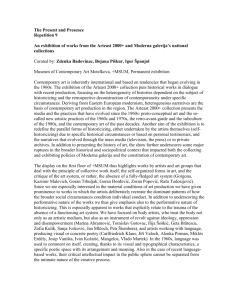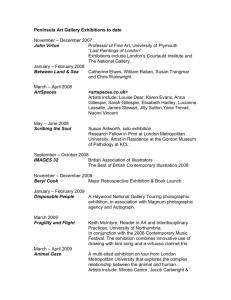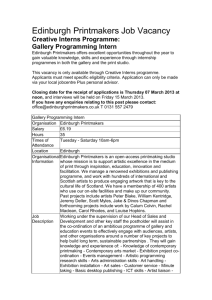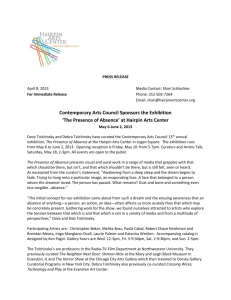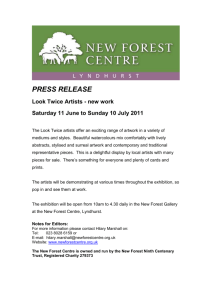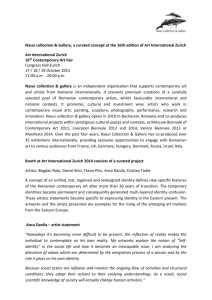50 Years Young! A Selection from the Collection of the Nitra Gallery
advertisement
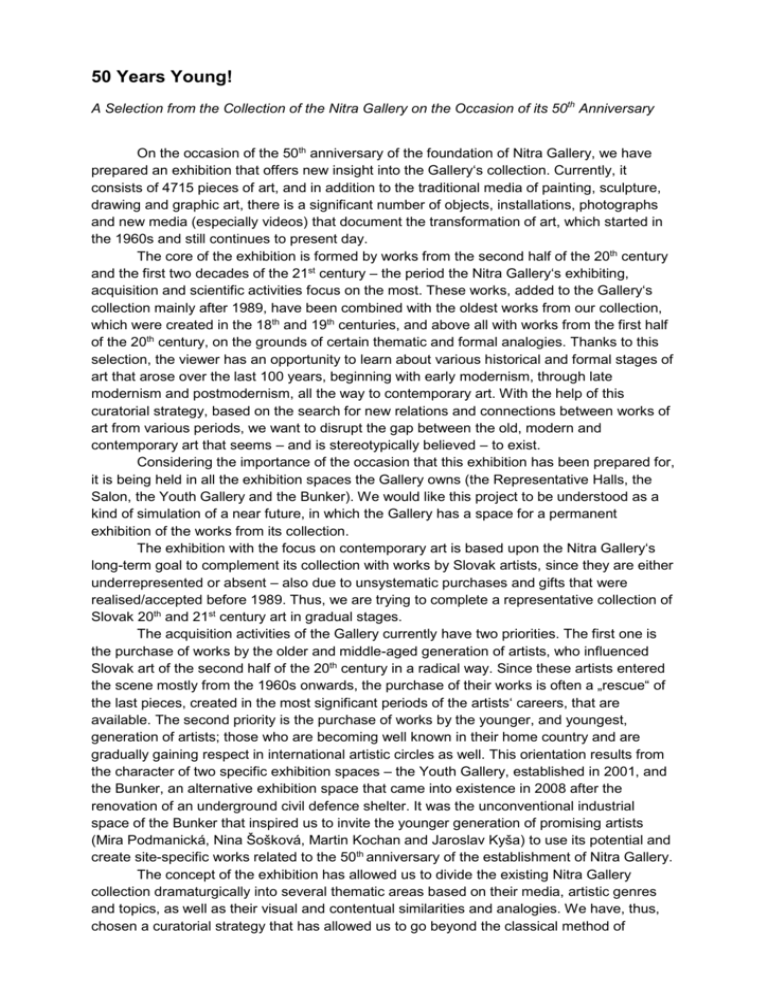
50 Years Young! A Selection from the Collection of the Nitra Gallery on the Occasion of its 50th Anniversary On the occasion of the 50th anniversary of the foundation of Nitra Gallery, we have prepared an exhibition that offers new insight into the Gallery‘s collection. Currently, it consists of 4715 pieces of art, and in addition to the traditional media of painting, sculpture, drawing and graphic art, there is a significant number of objects, installations, photographs and new media (especially videos) that document the transformation of art, which started in the 1960s and still continues to present day. The core of the exhibition is formed by works from the second half of the 20th century and the first two decades of the 21st century – the period the Nitra Gallery‘s exhibiting, acquisition and scientific activities focus on the most. These works, added to the Gallery‘s collection mainly after 1989, have been combined with the oldest works from our collection, which were created in the 18th and 19th centuries, and above all with works from the first half of the 20th century, on the grounds of certain thematic and formal analogies. Thanks to this selection, the viewer has an opportunity to learn about various historical and formal stages of art that arose over the last 100 years, beginning with early modernism, through late modernism and postmodernism, all the way to contemporary art. With the help of this curatorial strategy, based on the search for new relations and connections between works of art from various periods, we want to disrupt the gap between the old, modern and contemporary art that seems – and is stereotypically believed – to exist. Considering the importance of the occasion that this exhibition has been prepared for, it is being held in all the exhibition spaces the Gallery owns (the Representative Halls, the Salon, the Youth Gallery and the Bunker). We would like this project to be understood as a kind of simulation of a near future, in which the Gallery has a space for a permanent exhibition of the works from its collection. The exhibition with the focus on contemporary art is based upon the Nitra Gallery‘s long-term goal to complement its collection with works by Slovak artists, since they are either underrepresented or absent – also due to unsystematic purchases and gifts that were realised/accepted before 1989. Thus, we are trying to complete a representative collection of Slovak 20th and 21st century art in gradual stages. The acquisition activities of the Gallery currently have two priorities. The first one is the purchase of works by the older and middle-aged generation of artists, who influenced Slovak art of the second half of the 20th century in a radical way. Since these artists entered the scene mostly from the 1960s onwards, the purchase of their works is often a „rescue“ of the last pieces, created in the most significant periods of the artists‘ careers, that are available. The second priority is the purchase of works by the younger, and youngest, generation of artists; those who are becoming well known in their home country and are gradually gaining respect in international artistic circles as well. This orientation results from the character of two specific exhibition spaces – the Youth Gallery, established in 2001, and the Bunker, an alternative exhibition space that came into existence in 2008 after the renovation of an underground civil defence shelter. It was the unconventional industrial space of the Bunker that inspired us to invite the younger generation of promising artists (Mira Podmanická, Nina Šošková, Martin Kochan and Jaroslav Kyša) to use its potential and create site-specific works related to the 50th anniversary of the establishment of Nitra Gallery. The concept of the exhibition has allowed us to divide the existing Nitra Gallery collection dramaturgically into several thematic areas based on their media, artistic genres and topics, as well as their visual and contentual similarities and analogies. We have, thus, chosen a curatorial strategy that has allowed us to go beyond the classical method of chronological classification of artworks and their linear reading in the context of the history of art. The thematic area related to the genre of portrait is represented in the highest numbers at the exhibition. We are presenting portraits in various forms, from historical (Jozef Zanussi), through classical (Maximilián Schurmann, Raimund Wichera), modernist (Ladislav Guderna), surrealist (Karol Baron), all the way to their most current forms (Peter Ančic), in order to show their transformation in terms of style and the media used (eg. sewn textile portraits by Vlasta Žáková), as well as in terms of a new understanding of this genre, where the features that are inextricably connected with portraits (a face, a head), may be absent (Peter Meluzin). In a special subgroup, a selection of self-portraits is presented. There, fundamental differences are visible in the understanding of the artistic subject (Milota Havránková, Rudolf Sikora), often reduced to a signature (Michal Murin); as well as, surprisingly, certain formal similarities between the present (Veronika Rónaiová) and the past (Ladislav Guderna). A surprising effect can be perceived when comparing a traditional portrayal depiction of Milan Rastislav Štefánik (Gustáv Adolf Schüle) with a current attempt to personally come to terms with the personality of this scientist and statesman (Martin Piaček). Another work by Martin Piaček that is presented, titled Touching the Hero, falls beyond our traditional understanding of genres (portrait above all). The installations contain a figurative link to the identity of the public figures depicted, although it is not directly related to their physiognomy or character, but to the manner of their tragic deaths. The artist works with collection objects – relics, which refer to four significant figures from the Slovak history: Juraj Jánošík, Ľudovít Štúr, Milan Rastislav Štefánik and Alexander Dubček. Another classical genre presented at the exhibition is the still life, mainly represented th by 20 century artists (František Studený, Milan Paštéka, and others). By combining some modernist still lives, dominated by the matter-of-factness of things (the motif of a bottle in the works by Ester Šimerová-Martinčeková and Ladislav Guderna), with three contemplative objects from the Etuis cycle by Monogramista T. D, we have created a visually suggestive subgroup. Not only for the sake of amusement, we have created a pair, where a still life with the theme of a traditional Slovak food – bacon and bread (František Studený) – is linked to the view of a contemporary artist, who perceives bacon smoked by his grandmother as the symbol of home (Tomáš Džadoň, animation titled Slovakearth). Currently, the artists of the youngest generation are returning to traditions, seeing them in a new context and using the contemporary language and media. In an attempt to show analogies between older and contemporary arts, categories have been created that confront works based on their genres, like in the case of bust (Ladislav Čarný, Jozef Kostka), or of the various forms of depicting landscapes, whether these are natural (Ernest Zmeták, Michal Czinege, Maximilán Schurmann, Bohdan Hostiňák), urban (Lucia Tallová), conceptual (Juraj Bartoš), Slovak mountains (Martin Benka, Miloš Alexander Bazovský, Edmund Gwerk, Vladimír Popovič), or with the motif of the sea (František Studený, Ladislav Guderna, Orest Dubay, and Rastislav Podoba). In some other categories, our starting point was the related theme of the works, for example when we introduce the depiction of Christian iconography in a traditional form (Elias Mögel) and in an innovative, contemporary form (Dorota Sadovská, Klára Bočkayová and Matúš Lányi). The Madonna and Child motif– so common in historical art – is presented in a more modernist, secularised form of a mother with her child (Gustáv Mallý, Július Bártfay, Ján Mudroch), which is confronted with a video by Vladimír Kordoš, quoting the Renaissance painter Giovanni Bellini. The celebration of a woman also appears in the motif of a rural bride (Janko Alexy). Its counterpoint is the approach of young artist Lucia Tallová, who has appropriated period wedding photographs from the beginning of the 20th century, which she comments on using the medium of painting. Works that deal with the theme of death are also part of the exhibition. The skull as one of the traditional vanitas symbols is thematised in the contemporary paintings by Robert Bielik. Another aspect is represented in the expressive stylisation of the Indian ink drawings by František Studený from the 1940s. We have succeeded in creating interesting „neighbours“ in the section where – through the works of several artists – we have indicated a full spectrum of possible approaches to the motif of music – from the classical bust (the portrait of composer Ludwig van Beethoven by Július Bartfay), through figural genre art compositions (the theme of concerts by Ernest Špitz) and a more abstract painting of a musician with cubist features (Ester Šimerová-Martinčeková), all the way to the experimental – flat as well as threedimensional – graphical scores by Milan Adamčiak. In a similar way, we have conceived a section that shows various forms of the nude, where – through comparing the contemporary female artists‘ (Jana Želibská and Monika Pascoe Mikyšková) way of tackling this theme with the approach of the older generation (Rudolf Uher, Eugen Krón and others) – fundamental differences in ideas and concepts have become apparent. The only exception might be an object by Marián Mudroch, where he has appropriated nudes of women walking down the stairs by three significant artists – Eadweard Muybridge, Marcel Duchamp and Gerhard Richter. The notion of the book as an object, a phenomenon of the second half of the 20th century, represented at the exhibition in some works by Rudolf Fila, Peter Kalmus and Martin Derner, is confronted with a classical still life oil painting by Hungarian painter Alfred Lakos from the beginning of the 20th century. Another type of interesting „neighbourhoods“ arose around works based on simple, often witty, visual analogies – like the motif of legs in the works by Jana Farmanová, Vladimír Popovič and Jozef Theodor Mousson, the market theme (Jozef Theodor Mousson, Jozef Kollár and Mária Machatová), or the interior of a flat (Eugen Nevan and Monogramista T. D). A separate part is a group of works that comprise various forms of links to traditional Slovak folklore. We have created a kind of developmental scale, where we grouped a classical figural genre art scene (Ján Hála), its modernist stylisation (Milan Laluha), an ironizing addition of some typical folk objects (a traditional flask and ratchet) in the works of contemporary artists (Anetta Mona Chişa and Lucia Tk áčová) and the folklore that forms one of the layers of the hybrid, ironic-absurd pictures by the young artist duo Jarmila Mitríková and Dávid Demjanovič. The exhibition attempts to connect the past with the present on the basis of purely visual similarities of the depicted motifs. As a result, an unexpected and impressive combination of the classic artist Maximilián Schurmann‘s work with the contemporary photographs by Olja Triaška Stefanovič has been created. Another connection that might seem unexpected at first glance is that of the two historically distant artists – Martin Benka and Svätopluk Mikyta, whose exhibited works deal with the theme of mass gymnastics. While Mikyta criticises the ideological background of the socialist Spartakiad, Benka‘s paintings of the gatherings of the Sokol organisation, the member of which he was in 1909 – 1939, were made to order. A separate category consists of the works from the second half of the 20th century that deal with texts and letters as such in various ways (Juraj Meliš, Jiří Valoch, Peter Rónai and Miroslav Nicz). The exhibition also presents one of the relatively widely spread strategies of contemporary art, where the artists shift banal objects – such as pieces of clothing (Otis Laubert and Karol Pichler), handkerchiefs (Martin Knut), furniture and fishing rods (Pavla Sceranková) or cigarette butts (Michal Studený) – into new semantic and visual contexts. The principle of illusion is another interesting and multi-layered phenomenon, the aspects of which we have tried to illustrate on the diverse selection of the works from our collection that were created by artists active within the second half of the 20th century. These are the works that use the contemporary forms of trompe l‘oeil (Milan Bočkay), the illusion of movement (Milan Dobeš), space (Marko Blažo) or light (Martin Sedlák). The viewers are also confronted with a more sophisticated version of connecting virtual and real images (Mira Gáberová), the projection of illusionary human figures (Ilona Németh) and hyper-realistic details of the human body occurring in places where one would not expect them to (Stano Masár). As an example of the application of sociological and psychological strategies in contemporary art, we have selected two videos in which the artists use a monologue and a dialogue as two different forms of narration. While the work by Pavlína Fichta Čierna is a therapeutic monologue – an authentic patient‘s testimony of her mental illness that affects her every-day life, the video by Anetta Mona Chişa and Lucia Tkáčová is a dialogue – one where the two artists turn a typically masculine way of assessing women upside down, picking men as the sex objects of their ironic comments. We hope that – thanks to our choice of curatorial selection and the confrontation of works from diverse thematic, formal and contentual groups – we have managed to introduce our exhibition attendees, at least partially, to the diversity of our Gallery‘s collection, and to show them that new and old art can create very interesting connections; often challenging, unexpected or witty. Barbora Geržová & Omar Mirza

